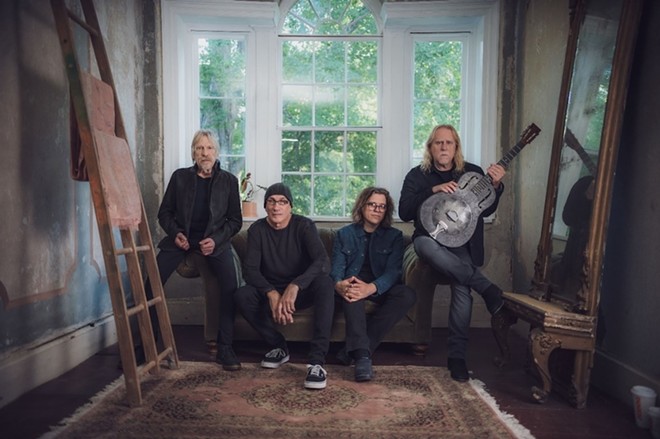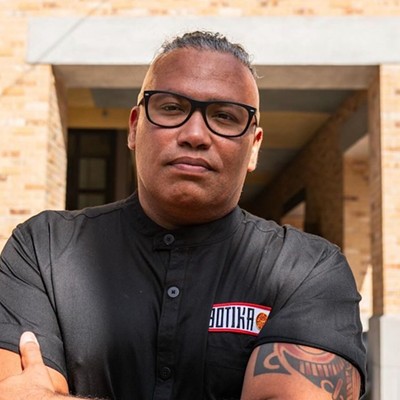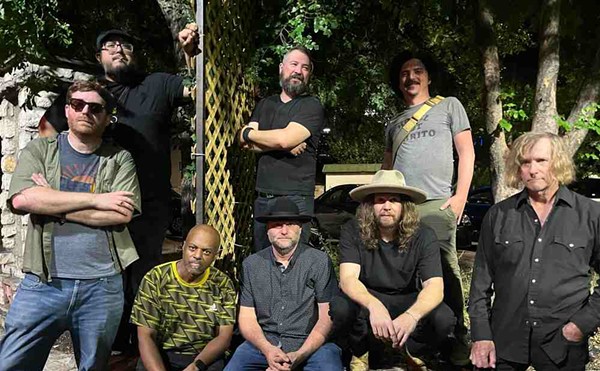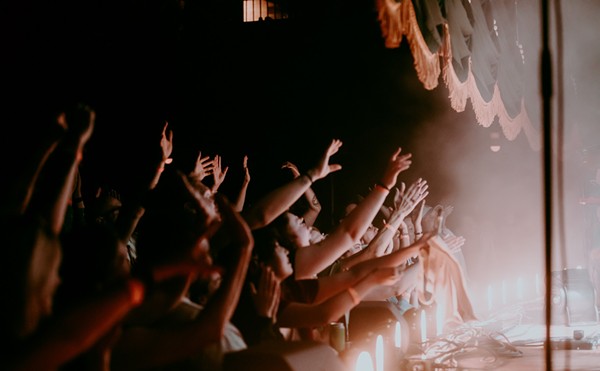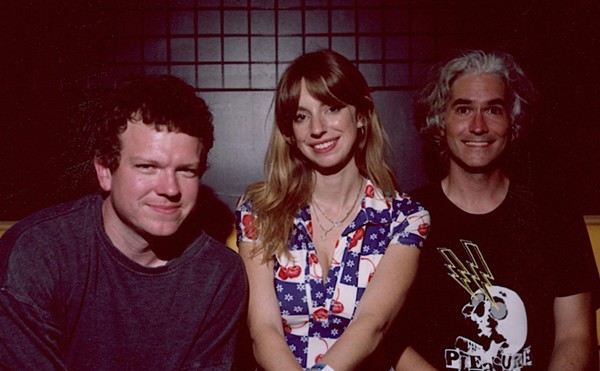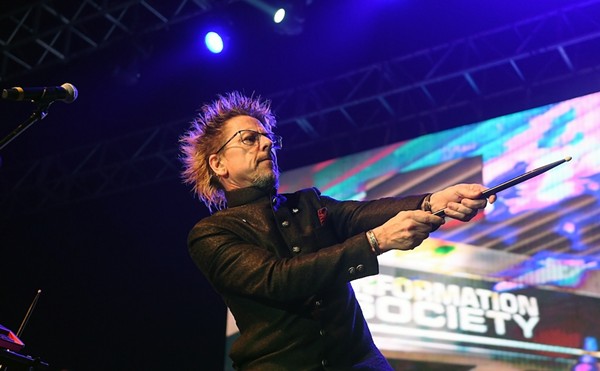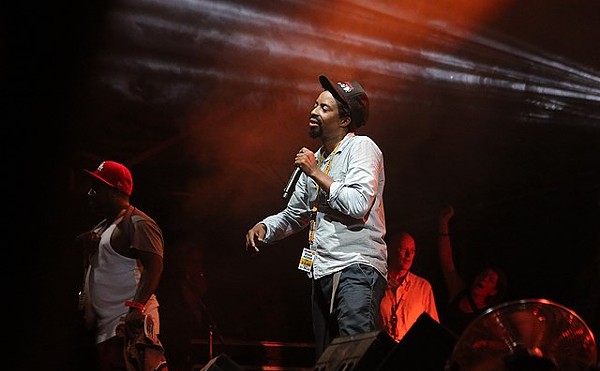For a while now, Haynes has focused his energy on Gov’t Mule, a seasoned foursome that plays a mix of blues and Southern-tinged hard rock. His soulful vocals and fleet-fingered guitar solos have wowed festivalgoers nationwide, and that band’s knack for extended improvisations has made it a fave with the jam band crowd.
All that’s no surprise when you consider that Haynes was an essential player in the Allman Brothers Band from the group’s 1980s revival until its end and that he also played a key role in the post-Jerry Garcia Grateful Dead world.
When Haynes and Gov’t Mule play San Antonio’s Majestic Theatre on Thursday, Oct. 27, don’t expect the band to rely heavily on funk — long the bread and butter of many of its jam band contemporaries. Mule sticks to an old-fashioned blues-rock template that invokes the Jimi Hendrix Experience, Cream and Mountain.
We talked to Haynes via Zoom, where he checked in from his hotel room in Fort Worth. Given that Halloween is almost here, we figured it would be a good time to discuss departed legends, ghosts and the Dead.
After all these years, you must have a strong bond with Mule drummer Matt Abts. What’s your connection like after playing together for decades?
There’s an unspoken connection. The beauty of keeping any band together is that whatever chemistry you’re building upon gets better and better and better. And there’s a communication factor. If the chemistry is right and you have the right people involved, the communication becomes borderline telepathic, where one person knows what the other person is thinking. Matt and I have that kind of relationship on stage. And since we’re taking like a jazz approach to rock music anyway, where every moment is influencing the next moment, that’s extremely important. Some of the stuff that happens onstage with us that’s completely unrehearsed is some of the most impressive stuff that we’re capable of doing — because of the way that we play together, based on how long we’ve been playing together and how well we know each other’s vocabulary and musical mannerisms.
How do you know when a jam is wrapping up? Do you have licks that let the other guys know, “OK, we’re going back to the regular changes?” Or is that more of the group mind that you were just talking about?
Sometimes there is a musical cue that brings us back. Sometimes it’s just a nod, a glance, a visual cue, and we know where we’re going back to. Sometimes there might be some sequence — musically — that we always end up with. Every situation is different. I think most of our jams tend to be based on visual cues that get us back to wherever we’re going.
You released Heavy Load Blues, the most recent Mule record, late in 2021. It has an interesting, pandemic-related origin. Tell me a little bit about the process that resulted in the album.
I had been thinking about making a blues record for probably five or six years. In the back of my mind, I didn’t know if it was going to be a Gov’t Mule record or a solo record. So, when lockdown came, I found myself writing more music than I’d written in decades. That was mostly based on the fact that I was home more than I had been since I was 15 years old. I don’t write a ton of what I consider to be blues songs. The blues is a big part of everything that I do, but I’ve only written a handful of what I would consider traditional-type blues songs in my life. But I wrote a few during the lockdown, and I have a few that existed prior that I had never recorded. So, the conversation came up: “What about making a blues record?” I thought, “Well, that’s a great idea. We have all this time on our hands.” But I only wanted to do it if we could do two albums at the same time, because I had written so much new material that I was dying to record. The mission became to find a studio that could accommodate two different setups. “We’ll set up for a blues record in one room, and set up for a rock record in the other room and make ‘em simultaneously.” So, we found this place in Connecticut that served that purpose. We set up all our normal toys in the big room with the high ceiling, and then the adjoining, small room with the low ceiling, we took in a bunch of small, vintage amplifiers and a small drum kit, and there was a piano and an organ. We used all vintage guitars and amps and microphones. Everything was recorded to analog tape, singing through a monitor with no headphones. Nobody wore headphones, and we were literally right on top of each other, like we were in a small club. So, there was no option to have modern separation in the recording where you could isolate each instrument. Every instrument was bleeding into every microphone, so it instantly gave the sound of those old records, because that’s the way those records were done. We would go in around noon and work on the normal Gov’t Mule record — if there is such a thing — and do that until about 8:30 or 9 o’clock at night, and then we’d take a break and move over into the blues room and play blues until 1 or 2 a.m. And that was our schedule every day. Normally, I wouldn’t prescribe that sort of method. During these circumstances, it was the perfect thing. Making the blues record was the perfect medicine in the way that, “We’re working on all this new Mule music in the main room, and some of it’s pretty complex.” Then, at the end of the day, we’d go shut our brains off and play blues and not think about it. Most of the tapes we kept were first or second takes. It was like cleansing your pallet or something.
Speaking of blues recordings, Robert Johnson’s first recording session was in room 414 of the Gunter Hotel, which is right down the street from the Majestic Theatre, where you’ll be playing. If you knew 100% that Johnson’s ghost was hanging out at your gig, what would you do differently?
I’d try to get even more lost in the music. It’s like the ghost of Jimi Hendrix being in the room. Try not to think about it, but try to breathe that spirit in. We would probably take on a little more traditional approach, I’m guessing. I wouldn’t know until the moment came. There’s a song on Heavy Load Blues —the title track, if you want to call it that — called “Heavy Load” that’s very old school, acoustic blues. We recorded it with two acoustic guitars. I played the old Robert Johnson model Gibson. I had never recorded with it before, until that song. The model I played on that song was the archtop version of the one he played as a flat top. That stuff is so heavy. Can I sidetrack for a minute?
Of course!
There’s some [Johnson] recordings floating around where somebody slowed them down based on the theory they were sped up initially. So, they’ve been slowed down to what this person thinks is the proper speed. And they sound better! More real. It’s quite amazing. I got them about ten years ago and I sent it to Bob Weir [of the Grateful Dead], and we were talking about it, and he was like, “Yeah, this is the real thing. This is more like it would have actually sounded.”
Speaking of the Dead, you’ve had a close relationship with those guys through the years. I’m thinking particularly of Grateful Dead bassist Phil Lesh. You were a member of the most celebrated lineup of his solo band. What was the most important lesson you learned from Lesh or Weir?
Well, for my own satisfaction it would be not to put so much pressure on the music, to let the music go where it’s gonna go. And just ride that wave. That advice wouldn’t work for 90% of the music being made on this planet. It only works for music that is trying to thrive off of improv. I’ll give you an example. When I joined the Allman Brothers, I was in [Allman Brothers guitarist] Dickey Betts’ band before. Dickey and I were already good friends by the time I was in the band. One day we were talking about the Dead and the Allman Brothers, and the similarities and the differences. And he said, “The big difference is that the Grateful Dead wait for the magic to happen and the Allman Brothers force it to happen.” He was saying it in a way like, “things are beautiful, but the Allman Brothers aren’t that patient. (Laughs.) We don’t have the patience to wait on it to happen.” So, when I started playing with Phil, the patience that he exudes musically … and eventually being part of [spin-off band] The Dead as well, it’s amazing that sometimes something will happen 30, 40, 50 minutes into the show, even later, that just takes it to another plane, but there was no rush to get there. That also carries over to their audience. Most bands don’t have an audience that’s gonna wait around for the magic to happen.
Mule has done a number of cover sets, themed sets, full-album covers. Let’s flip that. If — for whatever reason — another band had to do a full set of Gov’t Mule covers, what band could pull that off most effectively?
That’s a tough question. I’ve never thought of that. ... I don’t know if anyone would have the thought to do that!
Let’s sweeten the pot. Some band has a chance to earn $5 million, but they have to do a full set of Mule. Like winning the lottery, but with one condition. The bands that pop into my head are Drive-By Truckers or maybe North Mississippi Allstars. Could they do it?
I would be curious to hear either one of those bands approach our stuff, because they would both do a great job, but they would put their own slant on it. And they would pick the songs that fall into their own wheelhouse. Which, there would be plenty to choose from. And I thought of Umphrey’s McGee. They’re a band who would be brave enough and crazy enough, and obviously have the chops to tackle something like that.
You’ve talked in other interviews about your close bond with Gregg Allman. People used to say, “Oh, Stevie Ray Vaughan is up in heaven playing with Jimi Hendrix.” But we’ve lost so many legends in the last few years, that’s changed. If Gregg is up in heaven and he has the pickup band of his choice, who’s in it?
He’d definitely want his brother [guitarist Duane Allman]. He would want [Allman Brothers bassist] Berry Oakley in the band as well, but it becomes too easy if we just take the dead members of the Allman Brothers. (Laughs.) I think maybe James Jamerson on bass he’d probably love. Keyboards … it’s a hypothetical question, so can we put Ray Charles in there?
Why not? Who wouldn’t want to hear that?
B.B. King, he would want. From a drummer perspective, probably one of the guys that played with James Brown. There were so many that he really dug. I’m trying to think if there was one that would make the most sense. Saxophone? He loved horns. He was a huge Jimmy Smith fan. And Tina Brooks that played sax with Jimmy Smith. Although he also loved David “Fathead” Newman that played sax with Ray Charles. He was big into the horn section thing. He loved Tower of Power horns. Of course, they’re still around! He loved the idea of a horn section, just really liked that. We would play with the Juke Horns, who were from New Jersey, when we were at the Beacon [Theater] in New York. We would bring those guys out. He always loved that. But on drums … maybe Sam Lay? He is dead, right?
I’m not 100% on that. We can’t add him to the band of deceased legends too soon. I better fact check that and leave him out if he’s still alive. We don’t want to curse him. (Editor’s note: Lay died on Jan. 29, 2022.)
He’d probably be like me. Someone asked me a similar question: “What band would you put behind yourself, living or dead?” I started thinking about it and then said, “Just get another guitar player and singer. I’ll just listen. I don’t need to be in the band!”
$49.50-$150, 7:30 p.m. Thursday, Oct. 27, Majestic Theatre, 224 E. Houston St., (210) 226-3333, majesticempire.com.

